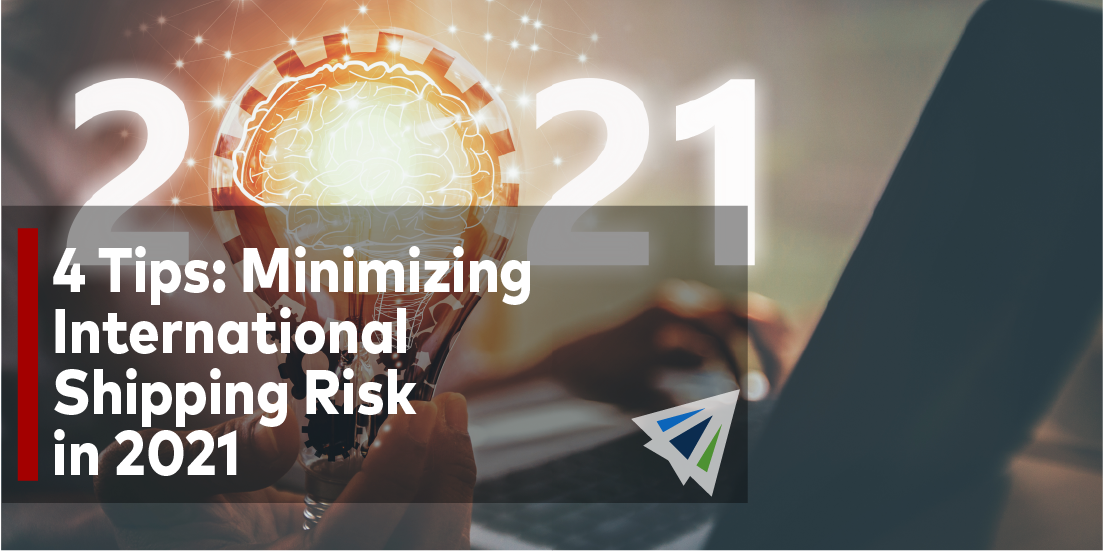If 2020 has proven anything to us all, it’s that you need to expect the unexpected. Risk poses an actual threat to businesses, and banking on a “hoping for the best” strategy isn’t the most proactive way to genuinely avoid the damage that can be caused by surprises in the shipping process.
The nice thing about risk is that, while some of it may be out of your control, most risk can be mitigated simply by staying informed and taking baby-steps to avoid obstacles as they come; not waiting for you-know-what to hit the fan and end up on your entire team.
Actually, the idea of risk-avoidance, staying informed, and creating a system of actual accountability is the concept that fueled The SHIELD Protocol – the only guaranteed solution to solving the 4 Great Burns of the industry. We’ve simply seen too many shippers burned by their providers.
4 Tips: Minimizing International Shipping Risk in 2021
If you’re looking to minimize international shipping risk in 2021, you’re on the right path. These are a few things you can do to ensure that business continues as usual with minimal hiccups in the process:
Review Shipping Policies
Excellence in business doesn’t come through “getting things in balance”, but rather playing the game of “continually balancing”. In other words, many companies will greatly optimize their supply chain, and after months or years of work, dust of their shoulders, step back and let things… slowly fall back into chaos.
Finding the perfect balance to “set and leave it” is an illusion. All factors that play into international shipping optimization are dynamic. Policies change over time. Duties and tariffs change. Trade policy is revised, and trade agreements change over time. The fine print on your cargo insurance changes. It’s all a moving target.
Going into 2021, take a look at everything, starting with the broadest factors down to the finest details you can think of. What policies are you currently relying on? When is the last time you reviewed if those have changed? How much are you spending on cargo insurance? These are all questions that can help you to reduce your international shipping risk in 2021.
Review Incoterms Changes
Incoterms don’t change super frequently, but when they do, it’s often a big change. And unfortunately, since people aren’t used to viewing incoterms as a dynamic element the same way they view tariffs and freight bills, incoterm policy changes frequently slip right past people.
Incoterms were recently revised on January 1st, 2020. While they weren’t major changes, it’s worth taking a look at (especially if you were previously shipping under DAT incoterms.)
Review Your Claims Process
You may have laughed at the addition of the word “process” to claims. Have you ever filed an international shipping claim? There isn’t really a process. It generally involves machine-gunning an email with choice vocabulary out to random carriers, asking your lawyer what you can do, and then sitting and waiting for ultimately, nothing to happen. International shipping claims are a MESS. In fact, it’s one of the 4 Great Burns of the International Shipping Industry (believe it or not…)
If you don’t have a claims process, we’ve made it incredibly simple through the development of Global Claims Assist (GCA). Global Claims Assist puts every single person who fingerprinted your cargo on notice of your demand for payment, creating a traceable and repeatable process for international cargo claims that doesn’t require an obscene amount of time investment.
Review Your Service Providers
One of the most common things that happens in companies who don’t review their service providers regularly is that they become victims of price creep. Price creep is the phenomenon that occurs when a client gets a little too comfortable with their vendor, so their vendor gradually increases their prices over time. Kind of a “frog in a pot of boiling water” phenomenon.
The other issue that occurs when shippers fail to review their shipping vendors is that they fail to recognize what a healthy vendor relationship looks like. Are you putting up with the same mistakes and issues over and over? Even if your vendor, such as a freight forwarder, isn’t making mistakes, are they simply acting as an ad hoc service provider, or are they providing you actual value through industry expertise and consistent supply chain coaching and advice?
These types of things often just fly under peoples’ radar when they’ve gone too long with a single provider without testing the waters to see what and who else is out there.
Final Thoughts
Risk mitigation is within your power. There will always be unforeseen circumstances, but most risk can be mitigated by making sure you are informed on new international shipping and global trade policies, reviewing incoterm changes and your current trade agreements, optimizing your claims process, and thoroughly reviewing your current service providers and 3PLs.
If you feel like you have lost sight of what a genuinely healthy and beneficial shipper-to-freight-forwarder relationship looks like, don’t hesitate to reach out to one of our team members. Seriously – call us to vent about the frustrations you’re having, or even to just bounce ideas off of us. We love a challenge, and coming up with specific and unique solutions that are optimized for each individual client is our strong suit. We look forward to chatting with you!
